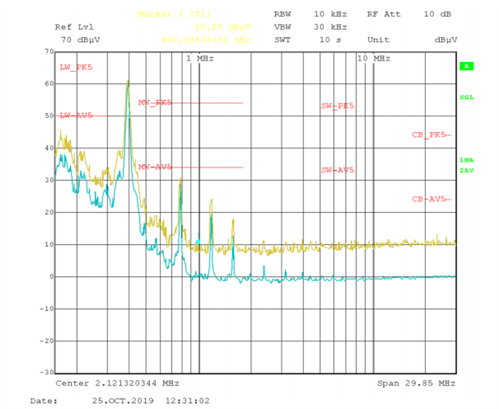SSZT222 november 2020 LMQ61460 , LMZ34002 , LMZ34202 , TPS62912 , TPS62913 , TPSM53604

From cart-based ultrasound scanners to portable smart probes that send images directly to a smartphone, the world of ultrasound imaging continues to diversify. Despite architectural differences in their design, every ultrasound system needs a DC power supply that can efficiently meet the power demands of the system and avoid interference with the ultrasound frequency range. In this article, I will review the primary design challenges when selecting a DC/DC buck regulator for medical ultrasound systems.
Synchronizing to external clock and minimizing interference
The buck regulator in the power supply must be able to synchronize to an external clock frequency. The ultrasound frequency band used for medical imaging is typically within the range of 2 MHz to 20 MHz. Therefore, when designing a switch-mode power supply for any ultrasound system, it is imperative that the switching frequency of the buck regulator does not interfere with the ultrasound band. A buck regulator with a low switching frequency will keep the fundamental and early harmonic frequencies out of the ultrasound band, but some harmonics will still persist. By synchronizing the switching frequency of the buck regulator to an external primary clock, you can control, monitor and precisely filter the switching frequency and its harmonics out of the ultrasound band.
While I’m on the topic of interference, it is also important to keep in mind the intrinsic electromagnetic interference (EMI) produced by any buck regulator in an ultrasound power supply. Even when the switching frequency and its harmonics are filtered, buck regulators can generate broadband frequencies that interfere with the rest of the system. Proper printed circuit board layout can greatly improve EMI, but to achieve optimum performance, consider using a buck regulator specifically designed to have low EMI. The LMQ61460, for example, has integrated bypass capacitors in addition to other design features (like external frequency synchronization) that minimize EMI. To confirm that a device truly has low EMI, check to see if the data sheet includes data from radiated or conducted EMI testing (or both) in the Other Common Conditions section. Figure 1 shows the conducted EMI of the LMQ61460.
 Figure 1 Conducted EMI of the LMQ61460
versus Comité International Spécial des Perturbations Radio 25 (limits: yellow,
peak signal; blue: average signal; FSW = 400 kHz; VOUT = 5
V; IOUT = 5 A)
Figure 1 Conducted EMI of the LMQ61460
versus Comité International Spécial des Perturbations Radio 25 (limits: yellow,
peak signal; blue: average signal; FSW = 400 kHz; VOUT = 5
V; IOUT = 5 A)Scaling to multiple power rails
A buck regulator that can handle multiple current and voltage requirements, including negative voltage rails, can be highly advantageous. Ultrasound systems typically have multiple power rails, each designed to rest at a different voltage and deliver a different current. You can use a device with a wide input voltage range, wide output voltage range and high-enough current limit to scale one power solution to all needed power rails (including negative output rails).
 Figure 2 Three Separate Power Rails.
Two Regulated with the LMZ34202 and One Regulated with the LMZ34002.
Figure 2 Three Separate Power Rails.
Two Regulated with the LMZ34202 and One Regulated with the LMZ34002.Ensuring high efficiency and power density
The medical industry continues its push to make ultrasounds more accessible by making them more portable. For battery-powered systems like portable ultrasounds and smart probes, the efficiency of the buck regulator under all operating conditions is essential to maximizing battery life. Portable applications also present the challenge of limited space. Although these are valuable features in stationary ultrasounds, to improve the portability of your system, consider selecting a buck regulator with:
- High efficiency at the preferred operating switching frequency.
- Low quiescent current to reduce battery drain during no-load and light-load conditions.
- High power density to save space.
Of course, it can be difficult to achieve high efficiency and high power density when working with switching power supplies that require additional filtering to minimize noise. In such scenarios, you might choose to work with specialized DC/DC buck converters, such as the low-noise and low-ripple TPS62912 or TPS62913, which offer excellent efficiency as well as external clock synchronization, and use integrated ferrite-bead filter compensation to filter out high-frequency noise.
Conclusion
When designing a DC/DC power supply for ultrasound, consider the unique demands of the system. The ability to synchronize to an external clock is paramount in order to effectively reduce and control harmonics in the ultrasound band. A buck regulator with a wide input voltage, wide output voltage and acceptable current limit will enable you to scale your solution and optimize your BOM. Finally, when selecting buck converters for portable applications, consider features such as high power density, high efficiency and low quiescent current to maximize efficiency.
Additional resources
- Check out these TI reference designs for more information about ultrasound systems.
- Read the application notes:
- “Topology Selection for Isolated Power Supplies in Patient Monitor” to explore an isolated power-supply design for ultrasound systems.
- "Working With Inverting Buck-Boost Converters” to learn how to determine input and output limits of a buck converter when implementing it as a negative output voltage rail.
- Watch the training video, “Rechargeable medical devices and their design considerations.”
- Read the technical article, “Minimize noise and ripple with a low-noise buck converter.”